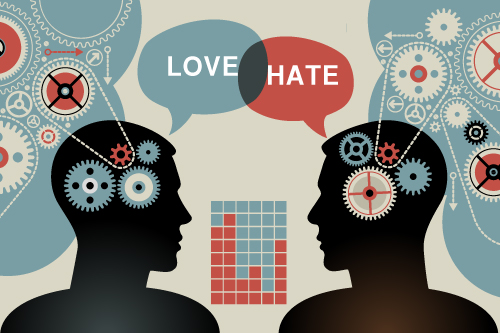 A couple of months ago a blogger called me “a self-taught hate-ologist, a journalist who tracks and reports on the various hermetically sealed world views that pollute public discourse (at their best) and spin out crazy people with grudges and weapons (at their worst).” She was right about what I do, but not so much about what I am.
A couple of months ago a blogger called me “a self-taught hate-ologist, a journalist who tracks and reports on the various hermetically sealed world views that pollute public discourse (at their best) and spin out crazy people with grudges and weapons (at their worst).” She was right about what I do, but not so much about what I am.


It’s true that I wrote a book called The New Hate: A History of Fear and Loathing on the Populist Right, and that I’ve contributed articles to the Southern Poverty Law Center’s Hatewatch blog. I am fascinated to the point of obsession with the hows and whys of hatred, especially programmatic hatreds that lead otherwise ordinary people to commit or condone terrible acts, whether as individuals—a George Zimmerman, say, profiling and shooting a Trayvon Martin—or on an organized basis: Hitler and the death camps; Mao and the Cultural Revolution; the mutual slaughters of the Hutus and Tutsis in Rwanda.
But “-ologists” by definition claim to have a much more comprehensive understanding of their subject than I ever could. I wish I really were a hate-ologist, because until we understand what causes such global hatreds, we won’t be able to find a cure for them.
Hatred isn’t so much an emotion for them as it is an organizing principle. It is as though a circuit in their brains is misfiring, or a pattern-seeking process has gone haywire, causing them to see a greedy Jew, a jihadist Muslim, a homicidal black (or whoever else the object of their obsession may be) hiding behind every lamppost.
Just this week Derek Black, the 24-year-old son of the White Nationalist leader Don Black—a young man who grew up in the red hot center of a hate movement, and who was publicly groomed to take his place as its leader—publicly renounced his racism. “It has become clear to me,” he wrote in an amazing open letter to the Southern Poverty Law Center’s Mark Potok, that “there is no way to advocate for white nationalism but by arguing that minorities pose a threat to our supremacy.”
“It is an advocacy that I cannot support,” he continued, “having grown past my bubble, talked to the people I affected, read more widely, and realized the necessary impact my actions had on people I never wanted to harm.” Black described his estrangement from the movement that was his birthright as “a gradual awakening process” that only seems sudden; he acknowledged his long-standing reluctance to “drive a wedge” between himself and his father and his community, but concluded that it was in the “best interests of everyone involved, directly or indirectly, to be honest about my slow but steady disaffiliation from white nationalism.” Let the dead bury the dead, indeed.
Does the younger Black’s conversion provide proof that the hating brain can be rewired? Perhaps it proves just the opposite—that for all the conditioning he had been subjected to, for all his lifelong schooling in the theory and praxis of hatred, his brain had been wired differently from his father’s all along, allowing him to experience a healthy cognitive dissonance as he grew into his independence. Perhaps it demonstrates that if a hard-wired hatred is of an altogether different order, a hatred that is merely learned or imitated can be unlearned. It gives real reason for hope, because as poisonous as hate leaders may be, they lose much of their power to do harm if they can’t hold on to their followers.
The brain does have a “hate circuit,” they found, which involves multiple structures, including some in the cortex and the subcortex, that are important in generating aggressive behavior. It also involves a part of the frontal cortex that has to do with predicting other people’s actions—a critical function when one is preparing to fight.
Back in 2008, two neurologists at University College London, Semir Zeki and John Romaya, undertook a similar experiment, wiring up 17 subjects and watching their brains as they looked at a picture of a person they professed to hate. (Personal hate, of course, is not the same thing as the principled group hate of a white supremacist or an anti-Semite; all but one of the subjects, who picked a political figure, chose to look at pictures of an ex-lover or a professional rival.) The scientists presented their findings in a much-discussed paper entitled Neural Correlates of Hate.
The brain does have a “hate circuit,” they found, which involves multiple structures, including some in the cortex and the subcortex, that are important in generating aggressive behavior. It also involves a part of the frontal cortex that has to do with predicting other people’s actions—a critical function when one is preparing to fight. Two of those structures are the right putamen and the medial insula, which are also activated by romantic love. “While it is difficult…to be more precise about the nature of the links…what is not in doubt is that there is, in the behavioural sense, a strong link between [hate and love] and one can easily transmute into the other,” they concluded.
When love is activated, Zeki told Science Daily, “large parts of the cerebral cortex associated with judgment and reasoning become de-activated.” With hate, on the other hand, “only a small zone, located in the frontal cortex, becomes deactivated. This may seem surprising since hate can also be an all-consuming passion, just like love. But whereas in romantic love, the lover is often less critical and judgmental regarding the loved person, it is more likely that in the context of hate the hater may want to exercise judgment in calculating moves to harm, injure or otherwise extract revenge.”
Lovers are swept away by their emotion. Haters are, too—but as often as not, they act and think as though they are coolly rational: They construct theories, they parse evidence, and they discover hidden patterns and grand conspiracies. They are so smart, in other words, that they are downright stupid.
In the next few weeks, I will delve more deeply into this subject, examining the neurology of conspiracy theories, delusions, and extremist thought.
Related Articles




14 Comments
Jennifer Jackson
Thank you for this introductory analysis. The more I research neuroscience and affect theories, the more I’m persuaded we’re on the cusp of a quite different way of interrogating the oldest philosophical mysteries: self, Other, empathy, soul. Studying literature under this emerging paradigm changes how one speculates on subjectivities and the trajectories of change.
Important work. Don’t become discouraged.
Linda Jones
I have often wondered if that type of person is addicted to their own adrenalin. They are upset about something all the time.
ernie1241
There was also a study done many years ago (but I don’t recall the title or publication) in which highly ideological people were asked to read a short article and then, afterward, summarize its content.
The result was that highly ideological people could not accurately summarize the key points of the article because their brain apparently erased data which contradicted their political preferences or they exaggerated data which supported their own preferences.
One could infer from this that “communication” becomes very difficult with highly ideological people because they are not “hearing” what non-ideological people hear. They convert positive evidence adverse to their own ideology into negative evidence or vice versa.